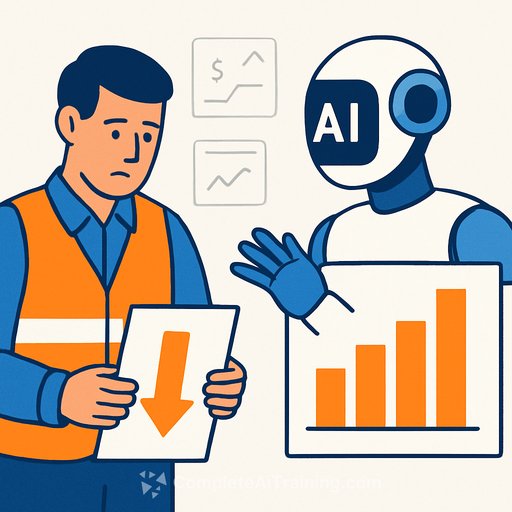Artificial Intelligence and Workforce Transparency: What Government Professionals Need to Know
The AI-Related Job Impacts Clarity Act is set to require publicly traded companies and government bodies to report staffing changes tied to AI to the Department of Labor. At its core, the bill compels organizations to disclose the number of employees laid off as a direct result of AI-driven automation.
For government teams, this is about building a clear record, not chasing hype. Bipartisan sponsors argue that good policy starts with clean data. They're right-speculation won't help workers, but standardized reporting might.
Why this matters now
Anxiety over AI and jobs isn't fading. Some tech leaders say entire categories will vanish. Others claim skilled trades will thrive. Trusting competing predictions won't cut it-public policy needs verifiable facts.
This initiative aims to replace guesswork with a consistent, nationwide picture of AI-linked job impacts. That helps with appropriations, oversight, and program design.
What you'll likely need to report
Based on current descriptions, expect at least one mandatory element:
- AI-attributed layoffs: The count of employees laid off as a direct consequence of AI-driven automation.
To add context (and reduce misinterpretation), agencies should be ready to track adjacent metrics even if they're not required on day one:
- Redeployments and reskilling after AI adoption
- New roles created because of AI (by occupation and location)
- Pay bands, job levels, and contract vs. FTE distinctions
- Automation type (e.g., software agent, robotics, decision support)
Immediate actions for agencies and public entities
- Stand up an AI impact reporting workgroup: HR, labor relations, procurement, IT, legal, and program ops.
- Define "AI-driven" and "direct consequence" now: Create inclusion/exclusion criteria with examples.
- Map occupations: Use SOC codes for consistent reporting and trend analysis across agencies.
- Instrument your HRIS: Add fields and reason codes to tag AI-related workforce actions.
- Build audit trails: Keep documentation linking AI deployment to staffing decisions.
- Coordinate with unions: Share definitions, timelines, and dispute resolution steps.
- Plan comms: Prepare internal FAQs and external summaries to avoid confusion once data is public.
Working definitions that prevent confusion
- AI-driven automation: A system that performs tasks or decisions previously performed by humans with minimal ongoing human input.
- Direct consequence: The layoff would not have occurred without the AI deployment (document the causal link).
- Exclusions: General cost cuts, seasonal changes, or unrelated restructuring should be tagged separately.
Data governance and privacy
- Minimize PII in reporting; use aggregated data where possible.
- Establish retention policies and access controls tied to labor audits.
- Document your methodology to ensure repeatability and fairness.
Procurement and vendor accountability
Many AI providers run on major cloud backbones, and tooling decisions can ripple into workforce plans. Your contracts should reflect that reality.
- Add AI-impact disclosure clauses to new contracts and renewals.
- Require vendors to provide change logs, model capabilities, and expected task displacement areas.
- Align acceptance criteria with workforce safeguards and training plans.
Support for affected workers
- Set early-warning triggers when AI pilots reach production and could affect staffing.
- Link alerts to Rapid Response and training programs.
- Track outcomes: time to reemployment, wage recovery, credential completion.
Useful references: U.S. Department of Labor and the BLS SOC system for occupation coding.
How to structure your reporting pipeline
- Intake: Catalog AI systems, use cases, deployments, and owners.
- Tagging: Add AI-related reason codes to headcount actions.
- Causality review: Require a short memo linking the AI system to the staffing action.
- Aggregation: Summarize by occupation, location, employment type, and timeline.
- Quality control: Quarterly audits; spot-check high-impact programs.
- Reporting: Produce machine-readable exports aligned to DOL specs once finalized.
What this signals for policy teams
Bipartisan interest means worker protections and transparency are moving to the center of AI oversight. This data can inform funding decisions, modernization budgets, and accountability for large-scale automation.
It also moves the conversation away from high-profile opinions toward measurable outcomes. That's good for workers and for credible governance.
What to watch next
- Final definitions of "AI-driven" and "direct consequence"
- Reporting cadence, thresholds, and penalties for noncompliance
- How much data is public vs. confidential
- Alignment with existing labor reporting and civil rights protections
Practical upskilling paths
If your agency is reallocating work due to AI, pair reporting with reskilling. Identify roles most exposed and offer short, applied learning aligned to daily tasks.
- Explore role-based AI training that supports redeployment: Complete AI Training - Courses by Job
Bottom line
You can't manage what you don't measure. Set up the plumbing for AI impact reporting now, document causality, and pair automation with real worker outcomes-redeployment, reskilling, and fair treatment.
Transparency is step one. Consistent standards and follow-through will decide whether this effort protects people-or just produces another report.
Your membership also unlocks:






